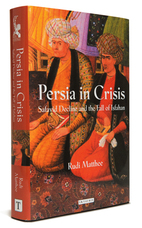 Did you know that Iran is listed in the Guinness Book of World Records for being the country with the most number of capitals in history? I heard that yesterday at a lecture entitled ‘The Decline & Fall of the Safavid Dynasty’ given by guest speaker at NYU Abu Dhabi, Dr. Rudi Matthee, who serves as the John and Dorothy Munroe Distinguished Professor of History at the University of Delaware, where he teaches Middle Eastern history, with a research focus on early modern Iran and the Persian Gulf. The one and a half-hour lecture took place at the recently built, impressive NYU Abu Dhabi premises in the Saadiyat Culture District, which is also home to the NYU Abu Dhabi Institute Conference Centre which ‘comprises a 300-seat lecture hall, a 185-seat auditorium, meeting rooms, and an entrance lobby that provides informal breakout areas for delegate interaction and discussion. It is the home of the NYUAD Institute, which provides a public forum for distinguished international thinkers to exchange ideas and engage with the Abu Dhabi community’. Dr. Matthee, author of several publications, the latest ‘Persia in Crisis’, shed light on the Safavids, one of the most significant ruling dynasties of Persia (modern Iran), that lasted from 1501-1722. The Safavids’ rule included all of modern day Iran as well as part of Georgia and Turkey but some would argue that they had the shorter straw sandwiched between two major powers at the time: The Ottomans in the West, and the Mughals in the East. So, why are they important? Because it turns out that the decisions they took and implemented have had repercussions that have extended well into modern day Iran. 1. The Safavids were to the first to impose Shi’ii Islam, banning all other religions as well as all forms of Islam including Sufism and Sunni Islam. 2. They unified the area with a core language: Persian. 3. The Safavids actualized a process of ‘Persianisation’ both at the state level and in society. Dr. Matthee went on to outline why the Safavids may have been doomed to fall from the day they came into power. One reason was their unenviable position between the two super powers at the time and the country’s scarce resources of timber (which is required to build ships hence no navy), and the extensive exploitation of its silver and gold by the British East India company and the Dutch Company which the Empire had joined forced with to further its economy and to protect itself from the Ottomans. Other elements include the geography of the land which contrary to popular belief is a vast land of dry desert, lacking in major water sources or navigable rivers. The majority of the population were nomads with non-existent urbanisation programs from the capital’s leaders. A major nail in the coffin was the decrease of secular power and the rise of religious power particularly at the time of Mohamed Baqir Majlisi in 1699 who reestablished clerical authority under his leadership and was responsible for propagating religious rituals that continue to this day in modern Iran. ‘The Safavids fell hard and quick due to real non-military efficiency’, explains Matthee. ‘They declared peace with the Ottomans and saw no need to reinforce the army’. What didn’t help matters at all was their un-neighbourly attitude towards the tribes on the periphery (the ethnic Iranians) who the Dynasty failed to placate and accommodate which ultimately meant that ‘the periphery turned on the centre rendering it a state hollowed out from the inside succumbing finally to tribal wars,’ explained Matthee. There are lessons to be learned when history is studied and reviewed. What the Safavids prove is that ‘for empires to exist allowances must be made. You cannot impose a dominant discourse that alienates the peripheries (the Sunnis, Christians, Armenians and the Jews in the case of the Safavids) without creating detrimental fissures’ concluded Dr. Matthee. For more on NYU Abu Dhabi Institute of public lectures, click HERE For a review of 'Persia in Crisis' by Dr. Rudi Matthee, click HERE
0 Comments
Your comment will be posted after it is approved.
Leave a Reply. |
Archives
March 2021
|




 RSS Feed
RSS Feed
